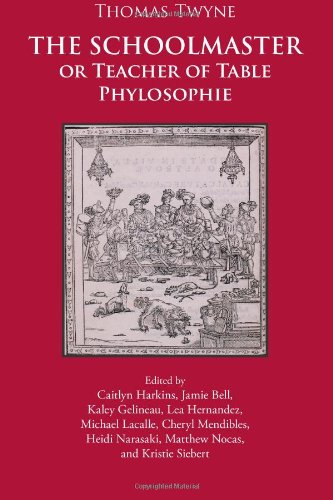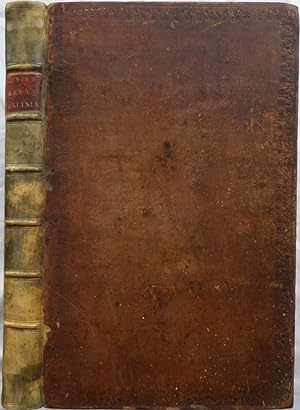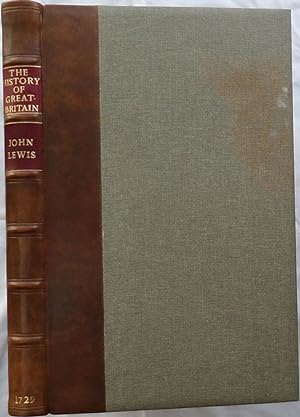thomas twyne (5 Ergebnisse)
Produktart
- Alle Produktarten
- Bücher (5)
- Magazine & Zeitschriften
- Comics
- Noten
- Kunst, Grafik & Poster
- Fotografien
- Karten
-
Manuskripte &
Papierantiquitäten
Zustand
Einband
Weitere Eigenschaften
- Erstausgabe (3)
- Signiert
- Schutzumschlag
- Angebotsfoto (3)
- Kein Print-on-Demand (4)
Land des Verkäufers
Verkäuferbewertung
-
The Schoolmaster: or Teacher of Table Phylosophie
Verlag: CreateSpace Independent Publishing Platform, 2013
ISBN 10: 1481098357ISBN 13: 9781481098359
Anbieter: Revaluation Books, Exeter, Vereinigtes Königreich
Buch Print-on-Demand
Paperback. Zustand: Brand New. 142 pages. 9.00x6.00x0.32 inches. This item is printed on demand.
-
The history of Great-Britain, from the first inhabitants thereof, t?ill the death of Cadwalader, Last King of the Britains;. To which is added, The breviary of Britayne, written in Latin.
Verlag: F. Gyles; Mess. Woodman and Lyon; and C. Davis, London: Holborn; Covent-Garden, and Pater-Noster-Row, 1729
Anbieter: Madoc Books (ABA-ILAB), Llandudno, CONWY, Vereinigtes Königreich
Buch Erstausgabe
Hardcover. Zustand: Very Good. 1st Edition. Lewis?s early history of Great Britain along with Lhuyd?s Breviary of Britayne VG, 1729, First & only edition, small elephant folio, in contemporary worn calf, blind edge tooling. Respined with polished calf, raised bands, the original red calf title label laid down. Internally, rubricated title, [6], [1], 2-71, [1], 251, [1]. [1], [16], [2], [1], 2-8, 13-32, 35-52 pp (odd pagination but complete), [2] woordes, [32] table, 13 large headers & numerous initial letters, hinges strengthened, a few chips to forward edge of fep, ink name to fep (T fransis Payne). The Breviary of Britayne has a separate title page dated 1573, the original date of publication, watermarked with horse within circle, text block edges sprinkled red, occasional contemporary ink marginal note. (Possibly limited to only 200 copies published?). (397*247 mm). (ESTC T113293. Allibone 1091. Brunet 1038. Libri Walliae 3280). Lewis, whose complete history was first published in 1729, over a century after its author's death, by the antiquary Hugh Thomas, perhaps using the text still extant in Harleian MS 4872 in the British Library. Like earlier Welsh historians, for instance Humphrey Llwyd (whose Breviary of Britayne is appended to the 1729 edition of Lewis's book), Lewis was reluctant to part with the much-criticized legends of ancient British kings, from Brutus the Trojan to King Arthur, as recorded by Geoffrey of Monmouth.
-
The History of Great-Britain, from the first Inhabitants thereof, 'till the Death of Cadwalader, .; and of the Kings of Scotland to Eugene V. and also a short Account of the Kings, Dukes, and Earls of Bretagne.in which are several Pieces of Taliessin, an antient British Poet, and a Defence of the Antiquity of the Scottish Nation . to this is added The Breviary of Britayne, written in latin by Humphrey Lhuyd . and Englished by Thomas Twyne.
Verlag: F. Gyles; Mess. Woodman and Lyon; and C. Davis, London: Holborn; Covent-Garden; and Pater-Noster-Row, 1729
Anbieter: Madoc Books (ABA-ILAB), Llandudno, CONWY, Vereinigtes Königreich
Buch Erstausgabe
Hardcover. Zustand: Near Fine. 1st Edition. Lewis?s early history of Great Britain along with Lhuyd?s Breviary of Britayne Near Fine, 1729, First & only edition, small elephant folio, in quarter calf (by Delrue) over cloth, some blind tooling. Spine, raised bands, gilt titles to red morocco labels, some blind tooling. Internally, rubricated title, [6], [1], 2-71, [1], 251 pp, [1]. [16], [6], [1], 2-8, 13-32, 35-52 pp (odd pagination but complete), [2] Welsh woordes (sic), [32] table, 13 large headers & numerous initial letters, mark to upper board, new endpapers, evidence of removed bookplate to fpd. The Breviary of Britayne has a separate title page dated 1573, the original date of publication, watermarked with horse within circle, text block edges sprinkled red, occasional contemporary ink marginal note. Possibly limited to only 200 copies?, ink name to tp (Arthur Blayney 1796/7 - of Gregynog?), evidence of bookplate removal to fpd. (390*238 mm). (ESTC T113293. Allibone 1091. Brunet 1038. Libri Walliae 3280). Lewis, whose complete history was first published in 1729, over a century after its author's death, by the antiquary Hugh Thomas, perhaps using the text still extant in Harleian MS 4872 in the British Library. Like earlier Welsh historians, for instance Humphrey Llwyd (whose Breviary of Britayne is appended to the 1729 edition of Lewis's book), Lewis was reluctant to part with the much-criticized legends of ancient British kings, from Brutus the Trojan to King Arthur, as recorded by Geoffrey of Monmouth. Text block in near fine condition.
-
PHISICKE AGAINST FORTUNE AS WELL PROSPEROUS AS ADVERSE, FORTY-SIX DIALOGUES
Verlag: Foolscap Press, Berkeley / Santa Cruz, CA, 1993
Anbieter: Oak Knoll Books, ABAA, ILAB, NEW CASTLE, DE, USA
full leather, clamshell box. Foolscap Press (illustrator). large 4to. full leather, clamshell box. 138 pages. Limited to 175 numbered copies. Here is a book that fairly crackles with wit and wisdom, for six hundred years have not dimmed its ability to speak to our minds through the clarity of its perspective, the power of its language, and the vivid pertinence of its thought. Because of the genius shown in his lyrical works, Francesco Petrarca (1304-1374) inspired the Renaissance in Italy. He set patterns and standards for the revival of learning and, at the same time, was a powerful advocate for the preservation of valuable manuscript material. From the classic models, Petrarch transmitted a refinement of taste and thought, and a polish and politeness of speech and style. This copy is bound in a full artist-binding by Don Etherington, bookbinder and former director of Conservation at both the Library of Congress and the Harry Ransom Center (Austin, TX). The binding is a full black and gray crushed moracco with leather onlay panels and ruling in blind. Leather spine label with title stamped in gray ink. Handmade headbands. Beautiful marbled paper makes up the pastedowns and endpapers. Stamped by the binder on the rear pastedown 'Don Etherington 2018'. The book is housed in a custom cloth-covered boards clamshell box with a leather spine label with the title stamped in gray. Petrarch's original manuscript, De remediis utriusque fortunae, or Remedies for Both Good and Bad Fortune, or Phisicke Against Fortune, is a work of prose consisting of two hundred and fifty-three dialogues that he completed near the end of his life. It represents a distillation of his moral philosophy arranged as a treatise that shows how our ideas and actions help us create either true happiness or sorrow and disillusionment. Throughout this long concatenation of dialogues Petrarch counsels modesty in prosperity and courage in adversity; he warns us against putting all our hope of happiness in mundane victories here on earth; instructs us on how to deal with our "Importunate Neighbours," tells us how to cope with "Loss of Time," and what to do when we experience "A Disagreeably Wavering Mind." For Foolscap Press the most difficult choice has been to select from the entire range of Petrarch's dialogues the forty-six that make up this edition. Introduction by Lewis W. Spitz Lewis W. Spitz, William R. Kenan, Jr. University Professor, Professor of history at Stanford University, brings his considerable scholarship to the question of Petrarch's influence on the northern Renaissance, as well as providing an overview of Petrarch's written works. Through background and example he shows why Phisicke Against Fortune is, as he says, "a mirror for mankind." Illustrations by Hans Weiditz Hans Weiditz (c.1495-c.1536) was an important member of the small group of outstanding woodcut designers of the German Renaissance whose membership included Albrect D'rer, Hans Holbein, and Hans Burgkmair. The fact that he was nearly alone in illustrating a great number of secular books makes him in many ways a more interesting artist than his more famous colleagues. Weiditz is best known for his illustrations for "Brunfels' Herbal," which is recognized as the most important herbal of the period and the first botanical book to contain realistic and accurate illustrations. Weiditz's imagination and close observation of real life show most clearly in this herbal and in his handling of the woodcuts for the dialogues of Petrarch. In illustrating Phisicke Against Fortune Weiditz demonstrates his highly individualized style and addresses an astounding range of issues, among which are: an individual's relationship to society; secular versus religious perspective; how we perceive and respond to nature and natural laws; and how we behave toward each other. As an appendix to the text we have included notes on the Weiditz illustrations based on information from Walther Scheidig and translated especially for this edition from the German by Beate Reid. Essay by William M. Ivins, Jr. In his essay on Hans Weiditz, William M. Ivins, Jr. (1881-1961), former Curator of Prints at the Museum of Modern Art, shares his infectious enthusiasm for the artist whose life had remained largely unappreciated until modern scholarship brought to light his great contribution to German Renaissance art. Translation by Thomas Twyne The Elizabethan Age was great both for the depth of its literature and the translations into English of many foreign works. Thomas Twyne's translation of Phisicke Against Fortune, from Latin into English, was completed in 1579. Now, newly transcribed from the Elizabethan blackletter, with the spelling and punctuation standardized, Twyne's translation can be clearly enjoyed. We have retained intact the particular character of the work and the marvelous flavor of the language. This edition brings together for the first time Thomas Twyne's translation of Phisicke Against Fortune and Hans Weiditz's wonderful woodcut illustrations which were made for the German edition of 1532. The original German edition contained two hundred and sixty-one woodcuts illustrating all of Petrarch's dialogues. We have selected forty-six dialogues that represent the enduring wisdom of Petrarch and the impressive imagery of Hans Weiditz. Limited to 175 copies, each book measures 12 x 9 inches and consists of 160 pages printed letterpress on Lana Royal, a mould-made paper from France. The text was set in Monotype as well as handset type using Poliphilus, Bembo Italic and Forum, with Calligraph Initials printed in red. 135 copies are hand-sewn and the rounded spine is covered in red Japanese cloth and is stamped in gold. Printed paper sides cover the boards. 40 copies are specially bound in quarter goatskin and red Japanese cloth and come in a slipcase covered in cloth and printed paper sides.
-
Phisicke against Fortune, as well prosperous, as adverse, contained in two Bookes [History of Gain and Fortune]
Verlag: Richard Watkyns, London, 1579
Anbieter: Rob Zanger Rare Books LLC, Middletown, NY, USA
Erstausgabe
Zustand: Very Good. First Edition. Small 4to; 7 1/2 x 5 5/8 in. (190 x142 mm); pp. [4] + xiv +1-152 First Booke, Physicke for Fortune: 153-343 Second Booke, Phisicke against Fortune + vi (table of contents) + [2]. Each book with Epistolary preface by Franucis Petrarche. Translated into English from Latin by Thomas Twyne whose introduction dedicates the work to "Richard Bertie Esquier." Title within woodcut decorative border, woodcut decorative initials, set in gothic and latin type, lacking sig.B and final blank, lower corner of title torn and repaired with loss supplied, first gathering lower corners repaired, some dampstaining and toning throughout but sheets supple and intact. 19th century calf, gilt, panels from early English blind-stamped binding laid down on covers, corners worn, rubbed. Front pastedown with small engraved bookplate with initials "I N" Title page reads: «Physicke against Fortune, as well prosperous, as adverse, contained in two Bookes Whereby men are instructed, with lyke in differencie to remedie theyr affections, aswell in tyme of the bright shyniyng sunne of prosperities, as also of the foule lowiyng stonnes of adversities. Expedient for all men, but most necessary for such as be subiect to any notable insult of eyther extremities. Written in Latine by Francis Petrarch, a most famous Poet and Oratour. And now first Englished by Thomas Twyne.» [STC 19809; ESTC S114602]. This is the first edition in English of "De Remediis Utriusque Fortunae" ("Remedies for Fortune Fair and Foul"), written in Latin by the Humanist Francesco Petrarca (1304-1374), commonly known as Petrarch, a collection of 254 dialogues, mostly drawn from classical sources, which seeks to instruct on moral philosophy and show how thought and deed can generate happiness on the one hand, or sorrow and disillusionment on the other. It touches on a number of diverse subjects, including dancing, ball games, gambling, wrestling, hunting and hawking, alchemy, libraries, schoolmasters, spectacles, toothache, lechery, gout, blindness, and deafness. In a recurring theme throughout the dialogues, Petrarch advises humility in prosperity and fortitude in adversity. It remained a popular book in Europe over the ages and was translated into English by the Elizabethan physician Thomas Twyne (1543-1613). "Latin work by Petrarch, begun in 1354 but completed between 1360 and 1366 , on how to deal with both good and bad fortune. The first of its two parts contains 122 dialogues between Ratio, Gaudium, and Spes, and deals with how one should behave at times of good fortune; the second contains 131 dialogues between Ratio, Dolor, and Timor, and deals with the behaviour appropriate to adverse fortune. It is a practical manual of moral philosophy, and was widely read until the 17th c." (Oxford Companion to Italian Literature).






![Bild des Verkäufers für Phisicke against Fortune, as well prosperous, as adverse, contained in two Bookes [History of Gain and Fortune] zum Verkauf von Rob Zanger Rare Books LLC](https://pictures.abebooks.com/inventory/md/md31703394489.jpg)